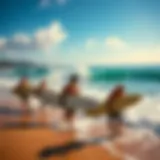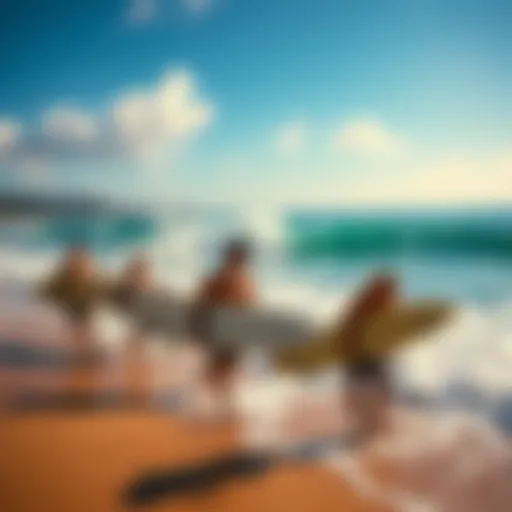Explore the Top Bodyboards for Watersport Enthusiasts
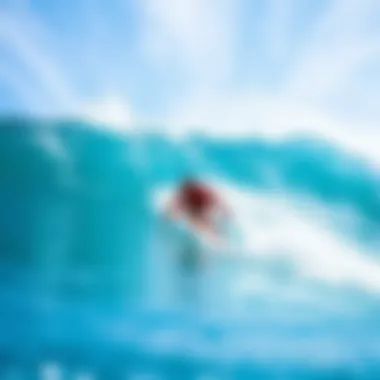
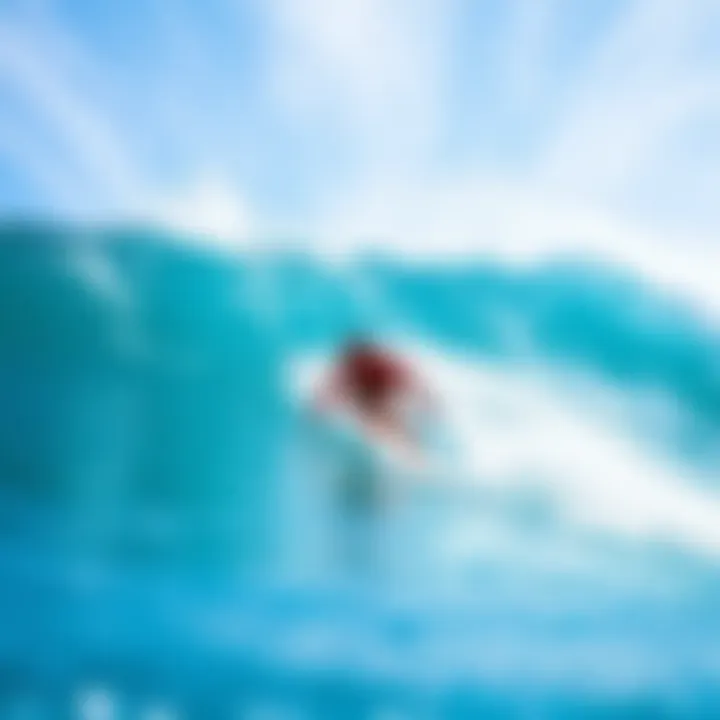
Intro
Bodyboarding is more than just a pastime; it's a way of life for many who seek adventure on the waves. From the thrill of catching a perfect wave to the intricacies of selecting the right board, there’s a lot to consider before hitting the water. Whether you are a seasoned surfer or a curious newcomer eager to dive into the world of watersports, understanding the nuances of bodyboarding gear is paramount. This guide aims to explore every facet of bodyboards, providing a roadmap for both novices and veterans alike.
Selecting the right bodyboard can significantly impact your experience in the water. Factors such as materials, shapes, and size all play a crucial role in how the board performs. It’s not just about picking the most colorful or flashy option; informed choices often yield a better ride and increased enjoyment.
As we delve deeper, we’ll highlight essential gear, top picks for equipment, and tips for maintenance. In the world of bodyboarding, taking care of your gear is just as vital as knowing how to ride. This not only extends the life of your investments but ensures your performance stays sharp on every outing.
From beginners trying to stay afloat to advanced riders maneuvering through complex tricks, the knowledge gained from this guide will arm you with everything needed for a fulfilling aquatic experience.
In the upcoming sections, we will address various segments crucial for enhancing your bodyboarding adventures. Prepare to discover the best bodyboards suited for diverse conditions, artistic styles, and performance demands.
Understanding Bodyboards
Bodyboards hold a special place in the world of water sports, offering a thrilling way to ride the waves. For surfers, paddleboarders, and anyone who finds joy in oceanic play, understanding bodyboards is paramount. This knowledge not only enhances your enjoyment but elevates your proficiency and safety in aquatic environments. The relationship between the rider and bodyboard is intricate; therefore, it's helpful to know how various features impact performance, durability, and overall experience.
By grasping the nuances of bodyboarding, you can make wise choices regarding selecting, using, and maintaining your gear. Whether you're an instructor imparting knowledge to students or a seasoned enthusiast refining skills, the insights gleaned from understanding bodyboards can greatly improve your time spent on the water.
With that, let's dive deeper into the elements that define what a bodyboard is and its purpose in the water sports realm.
Definition and Purpose
A bodyboard is a short, buoyant board typically made of foam that allows riders to catch waves while lying down or while kneeling. While the term "bodyboarding" might conjure images of casual beach leisure, it embodies much more than simply riding on a board. The purpose of a bodyboard goes beyond the fun; it facilitates a unique experience of connecting with the rhythm of the ocean. Riders maneuver through waves, experience the rush of water, and navigate dynamic sea conditions.
Bodyboards come in various styles and sizes, each tailored for specific wave conditions and riding styles. In this sport, the right board means everything. For instance:
- Performance: Some boards are designed for speed and agility, ideal for advanced maneuvers.
- Stability: Others focus on stability for beginners, providing a platform that encourages learning without overwhelming the rider.
- Durability: Built to withstand the harsh marine environment, bodyboards offer different levels of durability based on their material components, affecting lifespan and performance.
Understanding these factors allows riders to align their boards with their desired experience on the water – be it leisure, sport, or a combination of both.
History of Bodyboarding
Bodyboarding, often referred to colloquially as "boogie boarding," traces back to ancient times. Historical accounts suggest that indigenous cultures from the Pacific Islands utilized elongated wooden boards for wave riding long before modern versions emerged. The sport gained popularity in the mid-20th century, particularly thanks to Tom Morey, who invented the modern foam bodyboard in 1971. Morey's innovative design changed the game, making bodyboarding accessible to a wider audience.
The essence of bodyboarding evolved as the sport reached beaches globally, with riders experimenting with techniques and styles unique to their conditions. This surge in popularity spurred technological advancements in bodyboard design, ensuring the sport continued to thrive. The history of bodyboarding is a testament to the human connection with the ocean, illustrating how a simple concept can grow into a vibrant, dynamic subculture.
As you can see, understanding bodyboards encompasses various aspects that are essential for both enjoyment and performance. It is more than just a tool for surfing; it's a gateway to experiencing the beauty and challenge of the waves.
Key Features of Bodyboards
When it comes to bodyboards, understanding the key features is vital. Each element plays a significant role in performance and usability, directly impacting the overall water experience. From materials used to design considerations, these aspects cater to different skill levels and riding styles. Whether you are skimming over gentle waves or tackling challenging surf, selecting the right bodyboard can enhance your enjoyment and even improve your skills.
Materials Used in Construction
Materials are one of the most fundamental factors affecting a bodyboard's performance. The right material can influence buoyancy, responsiveness, and durability.
Polypropylene
Polypropylene is a plastic material often used for bodyboard construction. One of its key characteristics is the lightweight structure, which enables easy maneuverability. This material is known for its rigidity and flexibility, striking a nice balance that many riders appreciate.
Its lightweight nature allows for quick turns and rapid speed, making it a favorite among experienced riders. However, it can be prone to dings or damage if not handled carefully, especially in heavy surf. Overall, polypropylene serves as a popular choice for riders seeking agility in their boards.
EVA Foam
EVA foam, or ethylene-vinyl acetate, stands out due to its shock-absorbing properties. This material offers excellent comfort while riding, reducing the impact during tumbles.
Its unique feature is the ability to grip your body well, resulting in tighter control and better maneuverability. While this material quickly deteriorates under extreme UV exposure, proper care can significantly extend its lifespan, making it a sensible pick for enthusiasts who prioritize comfort.


PE Core
Polyethylene, commonly referred to as PE core, is another staple in bodyboard design. Its primary characteristic is its flexibility--allowing for incredible responsiveness when catching waves.
This material delivers a somewhat softer ride, giving it an edge for beginner and intermediate riders. However, its softness can also mean less durability compared to more rigid materials like polypropylene. Finding the right balance between flex and durability can make this choice a bit tricky.
Design Considerations
Design features further refine bodyboard performance. Key variations in shape, size, and tail configurations can enhance how well a board performs in specific conditions.
Shape Differences
Shape differences among bodyboards are essential to consider. They influence how a board interacts with the water, impacting stability and speed. For example, a wider shape may offer additional buoyancy, ideal for a beginner learning to ride. Conversely, a narrow outline provides agility and precision, appealing to seasoned surfers.
Each shape brings advantages and disadvantages, thus influencing your choice according to personal preference and skill level.
Dimensions and Size
Dimensions and size are crucial in ensuring that a bodyboard works well with its user. A shorter board generally allows for tighter turns, which is great for barrel rides. On the other hand, longer boards tend to provide better glide and carry more speed.
Sizing your board correctly isn't just about length—width and thickness also play significant roles. Some users mistakenly choose a board based solely on aesthetics rather than functionality. Getting the dimensions right can make all the difference when hitting the waves.
Tail Shapes
Tail shapes can drastically change how a board behaves on the water. For example, crescent tails can offer sharp turns and increased control, particularly during quick maneuvers.
Others, like square tails, provide stability and are often favored for softer waves. This characteristic can help you gain the most out of various conditions, ultimately feeding into your overall performance and experience. Picking the right tail shape should align with both your style and the type of waves you intend to surf.
Selecting the Right Bodyboard
Choosing the right bodyboard can feel daunting, especially amid all the options on the market. This decision can significantly impact your performance and enjoyment in the water. Bodyboarding isn’t a one-size-fits-all kind of sport. Each rider’s needs vary based on their skill level and the conditions they'll face. By focusing on specific elements, benefits, and considerations relevant to selecting the right bodyboard, you’re better positioned to find one that fits like a glove and serves you well.
Assessing Personal Skill Level
Understanding your own skill level is a vital first step in this process. The art of bodyboarding involves a range of techniques that differ significantly between beginners and seasoned riders. Beginners usually prioritize stability, while more advanced bodyboarders often look for maneuverability and speed.
- Beginner: If you’re just getting your feet wet, a wider and thicker board is often best. This design provides stability in the water and is typically more forgiving when it comes to catching waves. Look for a bodyboard that’s around 42 to 43 inches long, as this size is manageable and allows for easy paddling.
- Intermediate: Once you’ve gained some experience, you might start looking for boards that allow for tighter turns and more aggressive wave riding. At this stage, you may consider transitioning to a more performance-oriented bodyboard that is a bit narrower and more lightweight.
- Advanced: For those tearing through big waves, your board choice should reflect your style. You'll likely opt for a model that enhances quick maneuverability and speed. Boards in this category often feature sleek designs with contours that allow you to cut through the water efficiently.
When assessing your skills, it’s helpful to reflect on past experiences. Consider how comfortable you feel tackling different wave types and analyzing your riding goals. Seeking advice from experienced bodyboarders can also give insight into which boards suit your skillset.
Wave Conditions and Location
The type of waves you’ll ride heavily influences your board selection. Are you beach hopping in tropical waters or tackling rocky shore breaks? Each surf spot can demand different board attributes, and knowing where you'll be can help narrow your options.
- Beach Breaks: At beach breaks, the waves consist of softer peaks suitable for both beginners and experts. A bodyboard with good stability works well here. A board made from durable materials, such as polyethylene, will serve you well in these conditions.
- Reef Breaks: If you’re riding reef breaks, a more versatile board is essential. These waves can be more powerful and more technical. A thinner profile can allow for better maneuverability and hastened speed as you navigate those powerful walls of water.
- Point Breaks: These are known to provide longer rides with smoother faces. A bodyboard designed for speed can enhance your overall experience. Typically, a narrower board with a well-defined tail shape can give you the edge needed in these conditions.
- Local Considerations: It’s also worth taking local conditions into account. Factors like currents, tides, and local surf culture can provide valuable context to your board choice.
A solid understanding of these parameters can serve as a compass in your selection process, ensuring you have the best chance to ride the waves safely and effectively.
Always remember: the right board doesn’t just enhance performance; it can also elevate your enjoyment of the sport.
Engaging with local bodyboarding communities on platforms like Reddit or surf forums can also bring additional perspectives, especially about local wave conditions and the suited gear.
In summary, getting to grips with your skill level and the locations where you'll be riding will guide you toward the right bodyboard, ultimately enriching your experience in the water.
Top Bodyboard Brands
When it comes to bodyboarding, selecting a reputable brand can make all the difference between an unforgettable day on the waves and a frustrating experience. The right bodyboard can enhance performance, ensure safety, and elevate the joy of catching waves. Thus, understanding various top brands and their unique offerings is vital not only for beginners but also for experienced riders seeking to upgrade their gear.
Boogie Board Review


Boogie Boards have carved a niche for themselves that’s hard to miss. Known for their beginner-friendly design and affordability, these boards are often the first choice for those just entering the world of bodyboarding. Their lightweight structure and buoyant materials allow for ease of handling, making it simpler for novices to paddle out and catch smaller waves.
- Brand Strengths: Boogie Boards hold a reputation for durability despite their lightness. This means they can withstand the occasional knock against the sandy bottom without falling apart.
- Customization Options: Many Boogie Boards offer customization in their graphics and designs, which appeals to the aesthetics-driven audience.
- Affordability: For newcomers hesitant about investing heavily in gear, Boogie Boards provide great value without compromising on fun.
"Choosing the right brand can set the tone for your whole bodyboarding journey, so do your homework!"
Caught Inside Bodyboards
Caught Inside has emerged as a formidable name in the bodyboarding industry. Renowned for blending performance with cutting-edge technology, these boards are designed for serious riders who demand excellence with every ride.
- Performance Features: These boards often incorporate high-performance materials that improve speed and maneuverability. Riders are bound to notice the increased responsiveness, allowing for greater tricks and turns on the waves.
- Tailored to Surfers: Many boards are specific to wave conditions, whether for reefs or beach breaks, enabling riders to choose a board that aligns closely with their skills and surfing style.
- Eco-Friendly Options: Caught Inside also showcases a commitment to sustainability, using materials that lessen environmental impact. This makes it a great choice for eco-conscious surfers.
Noah Bodyboards
Noah Bodyboards have earned respect for their craftsmanship and solid performance. Those who venture into purchasing a Noah board are often seasoned riders looking for something they can trust in challenging conditions.
- Sturdy Construction: Built to endure, Noah boards are known for their robust design. Riders confident in their gear can take on larger waves without the fear of their board failing mid-ride.
- Custom Models: Similar to Caught Inside, Noah provides custom models that allow advanced riders to tailor their boards to suit particular waves or styles, making them a favorite among competitive surfers.
- Reputation in Competitions: With many champion riders utilizing Noah Bodyboards, the brand has established itself in the competitive scene, giving it additional credibility.
In the sea of bodyboard options, these brands represent a spectrum from beginner-friendly to advanced designs tailored for the serious rider. Understanding these options helps surfers make insightful choices that enhance their experience in the swells.
Bodyboard Maintenance
Bodyboard maintenance is a crucial aspect that often gets overlooked in the heat of chasing waves. Regular upkeep can significantly enhance the longevity and performance of your bodyboard. A well-maintained bodyboard not only ensures a better experience in the water but also provides safety while you ride the swells. It is essential to develop a consistent routine for maintaining your gear, as this practice safeguards your investment and enhances your enjoyment on the water.
When you treat your bodyboard with care, you’ve got a higher chance of it performing well over time. The effects of sun exposure, saltwater, and sand can accumulate quickly, leading to fading, warping, or even cracks. Treating these issues promptly can potentially save you from having to shell out for a new board sooner than expected.
Proper Cleaning Techniques
Cleaning your bodyboard after each use is one of the simplest yet most effective ways to prolong its life. Here are some techniques to keep in mind:
- Rinse with Fresh Water: As soon as you step off the waves, give your board a good rinse with fresh water to remove any salt and sand. This step is vital since both can damage the material and compromise its performance.
- Use Mild Soap: Occasionally, using a mild soap can help break down any stubborn dirt or grime. A gentle scrub with a soft sponge can work miracles without scratching the surface.
- Dry in the Shade: Let your bodyboard air dry, but avoid direct sunlight. While it’s tempting to bask your board under the sun, prolonged exposure can lead to warping. Instead, look for a shady spot to ensure it dries evenly.
"A little maintenance goes a long way; neglect can lead to big problems down the road."
- Check for Cracks and Dents: Regularly inspect your board for any cracks or dents that may develop. Addressing these issues early on can prevent further damage, ensuring your board stays in peak condition.
Storage Recommendations
Proper storage is as crucial as cleaning. If you want your bodyboard to remain functional and visually appealing, here are a few tips to consider:
- Cool, Dry Place: Avoid storing your board in a hot garage or trunk. Instead, find a cool and dry place to keep it, as excessive heat can severely affect its integrity.
- Avoid Pressure: Do not stack other items on top of your bodyboard. Pressure from other gear can lead to warping or creasing that will impact performance.
- Use a Bag: Investing in a bodyboard bag can protect your board from scratches and environmental damage. Look for padded bags that fit securely, allowing for easy transport while safeguarding your identity from the elements.
- Storing Vertically: If you have the option, store your bodyboard vertically. This way, it minimizes the impact of gravity and avoids any chances of bending or warping from weight accumulation.
Taking care of your bodyboard through regular cleaning and proper storage will ensure it stays in tip-top shape, ready for the next adventure out on the water. Being diligent about maintenance may seem like a chore, but the rewards—a pristine board and exhilarating rides—are well worth the effort.
Performance Evaluation
Evaluating the performance of bodyboards is a critical aspect of ensuring that you have the best possible experience while riding the waves. Success in this sport often hinges on more than just the ability to catch a wave; it's about how well the board performs once you do. Two of the most significant factors to consider in this evaluation are speed and maneuverability and durability and lifespan. Each of these elements contributes to the overall experience, enhancing your enjoyment and safety on the water.
Speed and Maneuverability
Speed is the bread and butter of bodyboarding. When you hit the water, you want a board that can glide seamlessly and accelerate with ease. Lighter materials typically offer improved speed, allowing for quicker response times as you paddle into waves. Conversely, boards that are too heavy can feel sluggish, making it harder to catch that perfect wave. Maneuverability is closely tied to speed; a responsive board allows you to twist and turn with agility, navigating the waves more effectively.
Some key features that can enhance speed and maneuverability include:
- Tail Shape: A more rounded tail can provide better lift and quicker turns, whereas a square tail can improve stability during high-speed rides.
- Nose Width: A narrower nose can help reduce drag, resulting in better speed.
- Rail Design: Sharper edges can give greater hold in the water, allowing for snappy turns and increased responsiveness.
Understanding the dynamics of your board can also affect your technique. A board designed for buoyancy may not be as responsive in tight turns, while one tuned for control will likely sacrifice some speed. Thus, matching a board's design with your need for speed and maneuverability is crucial for achieving your riding goals.
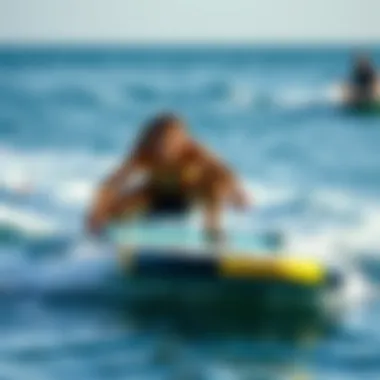
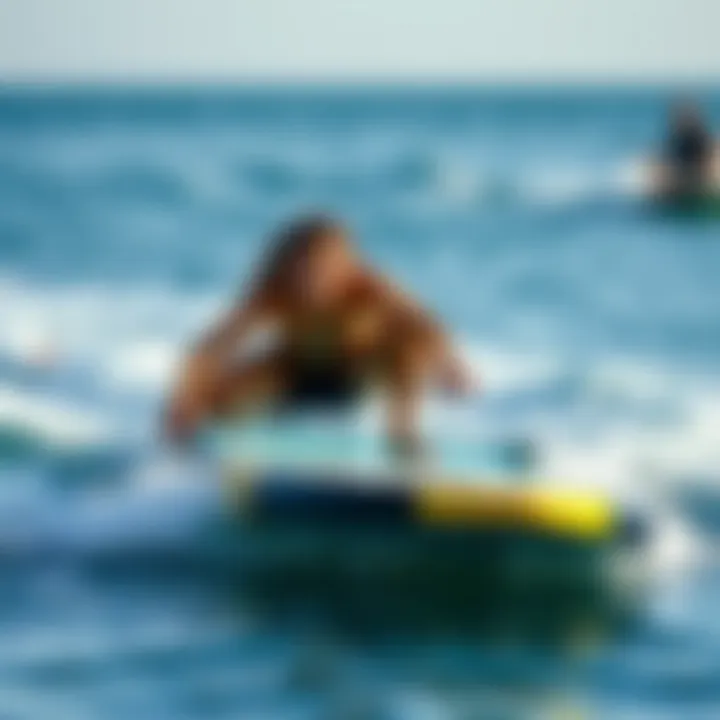
"A bodyboard isn’t just an object; it’s an extension of the rider’s body. Thus, understanding its performance capabilities can make or break your ride."
Durability and Lifespan
The durability of a bodyboard relates not only to how long it lasts but also to how well it maintains its performance over time. Bodyboards face wear and tear from water exposure, impacts against the ocean floor, and potentially abrasive sands and rocks. A robust board can withstand the rigors of usage without losing its functional qualities or structural integrity.
Here are several factors to keep in mind regarding durability and lifespan:
- Material Quality: Boards made with high-density polyethylene or a strong EPS core tend to be more resilient than others.
- Construction Techniques: Well-constructed boards often feature reinforced rails or high-quality lamination, reducing the chances of cracks and dings.
- Maintenance Practices: Proper care, such as rinsing off saltwater after each session and avoiding extreme temperature changes, can greatly extend a board's life.
When considering durability, those who frequently surf challenging conditions should particularly pay attention. A high-quality board not only provides better performance but also protects your investment. Analyzing your individual riding style and environment will help you determine which durability factors are most relevant to your needs.
In summary, both speed and maneuverability, as well as durability and lifespan, are vital components to weigh when evaluating bodyboards. Understanding these elements enhances your ability to choose a board that fits your riding style and ensures you can confidently face the waves.
Safety Considerations for Bodyboarding
Safety should never take a backseat when it comes to bodyboarding. While the thrill of riding waves is unmatched, understanding the potential risks involved can significantly enhance both enjoyment and safety during the experience. This section dives into crucial elements that every bodyboarder should be aware of, helping them stay safe while making the most of their aquatic adventures.
Understanding Beach Conditions
Before hitting the waves, knowing the beach conditions is paramount. This not only includes checking the forecast but also aware of factors like tide, swell height, and beach type. Certain conditions can turn a fun day into a treacherous one in the blink of an eye.
For instance:
- Tides: Different tides can affect wave behavior; high tide may result in stronger waves near the shore, while low tide can expose rocks and coral.
- Swell size and direction: It’s crucial to learn how to read these, as they influence wave power. Overhead waves can quickly become dangerous for inexperienced riders.
- Rip currents: These strong channels of water can pull swimmers and bodyboarders out to deeper waters. Awareness of their locations can become a lifesaver.
If you're unsure about the conditions, always consult a local surf report or ask lifeguards for their insight.
Choosing Safety Gear
Fins
The right fins can dramatically enhance your bodyboarding performance and safety. Fins provide necessary propulsion and make it easier to maneuver in the waves. A key characteristic of fins is their material; usually made from a combination of rubber and plastic, which ensures strength while maintaining flexibility. This combination aids in comfort and power.
One standout feature of fins is the strap system. Adjustable straps allow for a custom fit, reducing the likelihood of losing them while riding. Although beneficial, there’s a trade-off: a snug fit might cause discomfort over prolonged use. It’s also essential to consider the blade design. Stiffer blades are great for speed but can be challenging for beginners, who might prefer a bit more flexibility.
Leashes
Leashes serve as a crucial link between you and your bodyboard, ensuring that, even during chaotic wipeouts, your board stays close. The primary function of a leash is to prevent the board from drifting away and potentially hitting someone else or becoming a hazard in the surf. This safety gear generally comes in two materials: nylon and polyurethane, both serving the purpose but impacting durability differently.
One unique feature of leashes is the quick-release mechanism, which can allow for an easy detachment in emergencies. While this can be an advantage, one must practice using it, as improper handling might result in losing your board at a critical moment. Additionally, investing in a leash that matches your specific riding style—be it shortboard or boogie board—can ensure a tailored fit for best performance.
Consider this: using proper safety gear, such as fins and leashes, can mitigate risks, ensuring that your time on the surf is not only enjoyable but also safe.
With the right knowledge and equipment, bodyboarding can be an exhilarating journey through vibrant surf. Keep in mind the beach conditions, select suitable safety gear, and you've got a recipe for a fantastic day out on the water.
Finale
In wrapping up the discussion on bodyboards, it is crucial to underscore the significance of making well-informed choices when selecting these essential pieces of water sport equipment. Bodyboarding can be a thrilling, liberating experience, yet the right board can significantly enhance enjoyment and performance. A thorough understanding of the features—like materials, shapes, and size—enables water sports enthusiasts, from novices to seasoned pros, to choose boards that fit their personal styles and local wave conditions.
Emphasizing safety cannot be overlooked either. Knowledge of safety gear and the ability to read beach conditions are paramount in ensuring a fun, secure outing on the waves. In the end, this comprehensive guide serves as a roadmap, taking you through crucial considerations, and allows you to feel confident and prepared as you take the plunge into the ocean.
By adequately assessing your skill level and understanding the nature of the waves, you'll find a bodyboard that empowers rather than hinders your aquatic adventures.
Recap of Key Points
- Understanding Bodyboards: Defined what a bodyboard is and traced its history, providing insight into its evolution.
- Key Features: Explored essential details such as construction materials and design considerations, helping you identify what to look for.
- Selecting the Right Bodyboard: Discussed factors like personal skill level and wave environments as guiding principles in your selection process.
- Top Brands: Reviewed reputable brands, including Boogie Board, Caught Inside Bodyboards, and Noah Bodyboards, to guide your purchase decision.
- Bodyboard Maintenance: Emphasized the importance of proper care and storage techniques to prolong the life of your board.
- Performance Evaluation: Analyzed critical performances—speed, maneuverability, and durability—essential for your enjoyment and safety.
- Safety Considerations: Highlighted how to understand beach conditions and choose appropriate safety gear like fins and leashes.
Final Recommendations
When it comes down to choosing the right bodyboard, a few final thoughts can steer you in the right direction:
- Prioritize Your Preferences: Experiment with different boards to determine which feel suits your riding style and experience.
- Stay Informed on Gear: Follow trends and product developments from trusted sources to ensure your equipment stays current.
- Test Before You Commit: If possible, try out boards or rent them at your local beach to find the best fit for your unique needs.
- Invest in Safety: Always equip yourself with the necessary safety gear to minimize risks while maximizing enjoyment.
- Engage with Community: Join forums and local bodyboarding groups where you can share experiences and tips with others.
By adhering to these recommendations, you’ll not only enhance your ability to choose an effective bodyboard but also enrich your overall experience in the exhilarating sport of bodyboarding.


